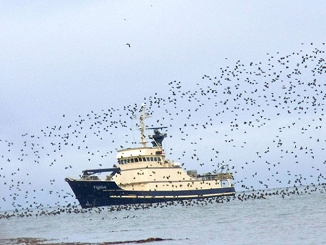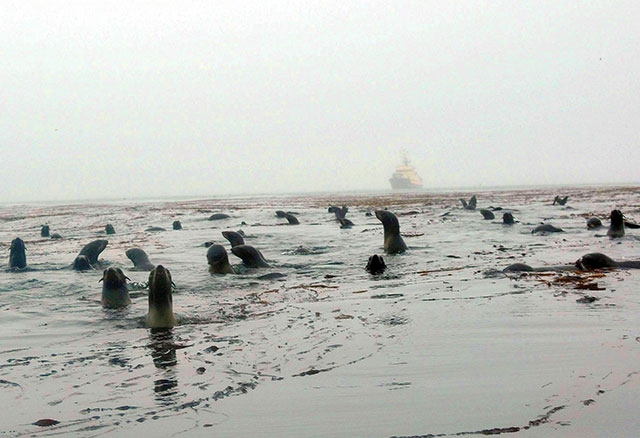 The Research Vessel (R/V) Tiglax (pronounced TEKH-lah) sails up to 20,000 nautical miles each summer in support of science and conservation within 3.4-million-acre Alaska Maritime National Wildlife Refuge. Photo by Brian Salem/USFWS
The Research Vessel (R/V) Tiglax (pronounced TEKH-lah) sails up to 20,000 nautical miles each summer in support of science and conservation within 3.4-million-acre Alaska Maritime National Wildlife Refuge. Photo by Brian Salem/USFWS
By Shaun Sanchez, deputy chief of the National Wildlife Refuge System
I’m no seaman, I admit. I’m proud to be a wildlife biologist. But nine days on the U.S. Fish and Wildlife Service Research Vessel (R/V) Tiglax vividly showed me how the intersection of the two professions strengthens both the Service and the critical research being done for and by universities, partners and other federal agencies.
RELATED:Tiglax Photo Story
A few facts stand out: The research and monitoring coming from the Tiglax is outstanding because we have dedicated professionals from both specialties. Day-to-day operations are seamless, thanks to Captain Billy Pepper, who has been at the helm for more than 20 years, and his crew. And gender plays no role: Women and men work side-by-side in tight quarters and often on rough seas to do work that makes a difference for conservation.
I boarded the Tiglax in Homer, Alaska, on July 14 and debarked at Kodiak National Wildlife Refuge on July 22. During my days on the 120-foot ship, we stopped at a number of islands in the National Wildlife Refuge System that hadn’t been visited by Service staff and some cases anyone in quite some time.
Some of the islands are part of Alaska Maritime National Wildlife Refuge, which spans 3.4 million acres and is home to seabirds that live and breed nowhere else. Other islands are part of Kodiak Refuge, which is celebrating its 75th anniversary this month. We also visited two other refuges: Alaska Peninsula and Becharof.

The Tiglax carries marine biologists, other scientists and land managers from various agencies, conservation partners and universities to destinations from Gulf of Alaska to the Aleutian Islands and beyond. En route they see a diverse array of marine wildlife, including sea lions. Photo by Brian Salem/USFWS
The trip focused on how refuges coordinate on seabird conservation and similar management challenges such as invasive species and operating in remote locations. We looked at the results of fox eradication within Alaska Maritime Refuge, and celebrated when we didn’t see any on the islands. However, our celebration was cut short when we saw impacts that cattle were having on a fragile island ecosystem. As we traveled the sea, we resupplied staff at a field camps on Chowiet Island.
The sights from the Tiglax are amazing. I saw humpback and fin whales nearly every day. And each night, we were treated to presentations by biologists on a range of subjects. Where else do we pack so much knowledge and dedication into such a small space?
Ready to ship out? Be prepared for long, intense days, potentially rough seas and a level of camaraderie found in few other places.
Have landlubber legs like I do? Then check out the Tiglax story this week on the Refuge System homepage.
